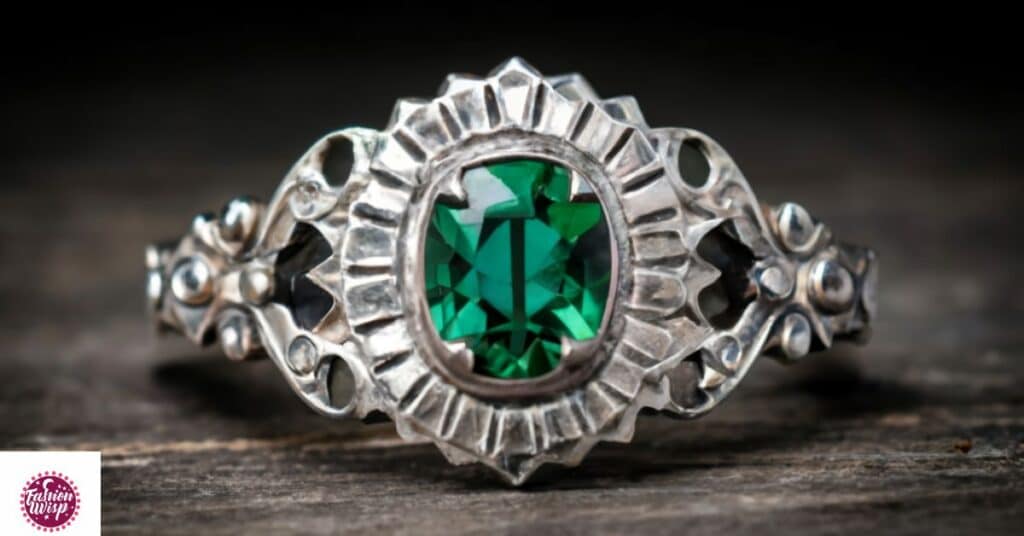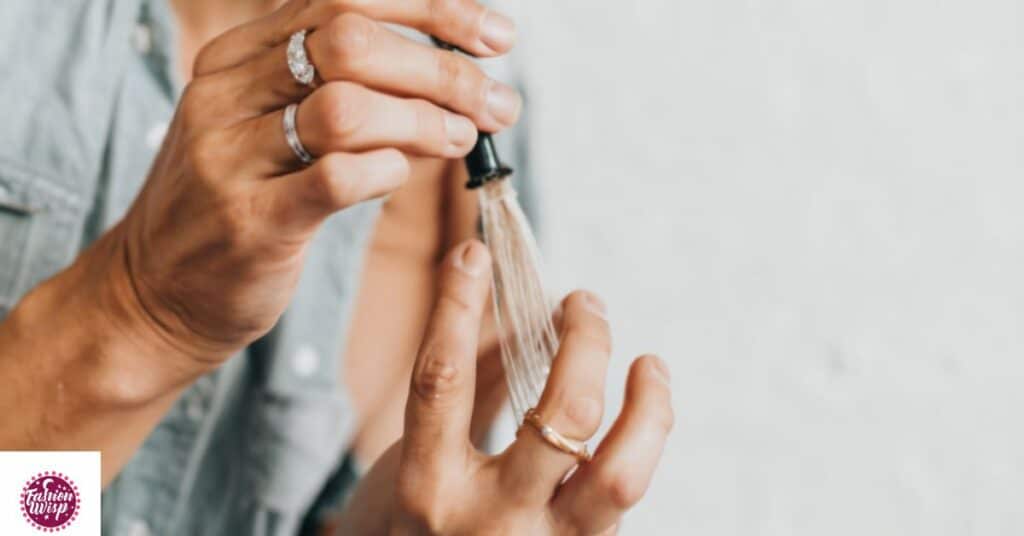Delve into the world of sparkle and sophistication with paste jewelry. A marvel of imitation, paste jewelry dazzles with its stunning resemblance to precious gemstones.
Crafted from glass, crystal, or gemstone imitations, each piece exudes timeless elegance without the hefty price tag. Originating from a blend of lead oxide and ground glass, paste jewelry emerged as a glamorous alternative during the 18th and 19th centuries. Adored for its intricate designs and affordability, it remains a cherished choice for vintage and costume jewelry aficionados, promising sophistication and allure in every shimmering detail.
Why is it called paste jewelry?

The term paste jewelry might sound peculiar at first, but its origins unveil the magic behind its name. Back in the day, craftsmen concocted a mixture resembling paste by blending lead oxide with ground glass. This paste-like substance was then molded into stunning imitations of precious gemstones like diamonds and rubies.
As these imitations bore a striking resemblance to genuine gemstones, they earned the moniker “paste jewelry. Despite lacking the intrinsic value of authentic gems, paste jewelry mesmerizes with its intricate designs and affordability. This clever blend of craftsmanship and creativity has cemented its place in the realm of vintage and costume jewelry, captivating enthusiasts with its timeless allure.
Read This Blog: Lana Del Rey Weight Gain: Exploring The Singer’s Changing Appearance
Unveiling the Craftsmanship Behind
The craftsmanship behind paste jewelry is a testament to creativity and skill. Through a meticulous process of blending lead oxide and ground glass into a paste, artisans mold stunning imitations of precious gemstones, capturing the allure of diamonds and rubies. Despite their affordability, paste jewelry pieces boast intricate designs, offering a glimpse into the rich history and artistry behind each shimmering detail.
Understanding the Composition of Paste Jewelry
Understanding the composition of paste jewelry delves into the chemistry behind its creation. This jewelry is crafted by blending lead oxide and ground glass to form a paste-like substance, which is then skillfully molded into stunning imitations of precious gemstones. Despite lacking the intrinsic value of authentic gems, the meticulous process ensures that each piece captures the brilliance and sparkle reminiscent of diamonds, rubies, and sapphires.
The Economic Significance of the Term “Paste” in Jewelry Terminology
The economic significance of the term “paste” in jewelry highlights its accessibility and affordability. Unlike authentic gemstones, paste jewelry offers a budget-friendly alternative without compromising on elegance and style. This affordability has made paste jewelry a popular choice for individuals seeking sophistication without breaking the bank, expanding the accessibility of glamorous accessories to a wider audience.
Is paste jewelry valuable?

The value of paste jewelry lies in its aesthetic appeal rather than intrinsic worth. While it may not hold the same monetary value as genuine gemstones, paste jewelry dazzles with its exquisite designs and affordability. Crafted from glass, crystal, or gemstone imitations, each piece showcases intricate craftsmanship that captures the allure of diamonds, rubies, and sapphires without the hefty price tag.
Although paste jewelry may lack the prestige of authentic gemstones, its affordability makes it a practical and stylish choice for fashion-conscious individuals. Whether adorning a casual outfit or adding sparkle to formal attire, paste jewelry offers versatility and elegance without the financial burden. Its value transcends monetary worth, embodying the creativity and artistry of its makers while allowing wearers to shine with confidence and sophistication.
Assessing Paste Jewelry’s Value
Assessing paste jewelry’s value involves considering its aesthetic appeal and affordability. While not inherently valuable in terms of precious materials, paste jewelry shines through its intricate designs and craftsmanship, offering an affordable alternative to genuine gemstones. Its value lies in its ability to adorn wearers with elegance and style without the financial burden, making it a practical and attractive choice for fashion-conscious individuals.
Value Beyond Monetary Worth
Value beyond monetary worth encompasses the emotional attachment and versatility of paste jewelry. While not as expensive as genuine gemstones, these pieces hold sentimental value as cherished accessories. Their affordability allows for experimentation with different styles, adding excitement and versatility to one’s wardrobe without a hefty financial burden.
Why is paste jewelry so expensive?

Paste jewelry is often perceived as expensive due to its meticulous craftsmanship and intricate designs. Each piece undergoes a labor-intensive process, from blending lead oxide and ground glass to molding imitations of precious gemstones. The expertise required to create these replicas, coupled with the attention to detail, contributes to the perceived value of paste jewelry.
Furthermore, despite being imitations, paste jewelry often incorporates high-quality materials such as glass or crystal to mimic the brilliance of genuine gemstones. This commitment to quality, along with the time and skill invested in crafting each piece, drives up its cost. While paste jewelry may not command the same prices as authentic gemstones, its perceived value lies in the craftsmanship and attention to detail that goes into its creation.
Also Read this Blog: How To Get Butter Out Of Clothes, Quickly And Easily
Decrypting the Intricacies of Paste Jewelry Pricing
Decrypting the intricacies of paste jewelry pricing reveals a blend of craftsmanship and materials. Each piece undergoes a labor-intensive process, from the meticulous blending of lead oxide and ground glass to the intricate molding of gemstone imitations. The expertise required and the attention to detail contribute significantly to the perceived value and pricing of paste jewelry.
Unveiling the Factors Elevating the Value of Paste Jewelry
The value of paste jewelry is elevated by its incorporation of high-quality materials, such as glass or crystal, mimicking genuine gemstones’ brilliance. Meticulous craftsmanship and attention to detail further contribute to its allure and perceived value, making it a desirable accessory for fashion-conscious individuals seeking elegance without the hefty price tag
What does it mean if a necklace is paste?
If a necklace is described as “paste,” it means that it is adorned with imitation gemstones made from glass, crystal, or other materials. Unlike genuine gemstones, which are naturally occurring and have intrinsic value, paste gemstones are manufactured to resemble their precious counterparts. The term “paste” originated from the mixture used to create these imitations, typically a blend of lead oxide and ground glass, resulting in a paste-like substance that can be molded into various shapes.
While paste necklaces may lack the monetary value of authentic gemstones, they often exhibit intricate designs and craftsmanship. These necklaces offer an affordable alternative for individuals who desire the elegance and sparkle of gemstone jewelry without the high cost. Additionally, paste necklaces come in a wide range of styles and designs, making them accessible to a broader audience and allowing for versatility in accessorizing various outfits and occasions.
Understanding Imitation Gemstones in Jewelry
In jewelry, describing a necklace as “paste” indicates that its gemstones are imitation, typically made from materials like glass or crystal. While lacking the intrinsic worth of genuine gemstones, these replicas still provide elegance and style at a more affordable price. Despite being replicas, paste necklaces often feature intricate designs and craftsmanship, appealing to those seeking sophistication without the hefty investment.
The Significance of Paste in Necklace Terminology
“The Significance of Paste in Necklace Terminology” underscores the affordability and accessibility of imitation gemstones. Describing a necklace as “paste” denotes the use of materials like glass or crystal in place of genuine gemstones. Despite their imitation nature, paste necklaces still offer elegance and style without the high cost, making them a favored choice for budget-conscious fashion enthusiasts.
What is paste jewelry made of?
Paste jewelry is crafted from a variety of materials, with the most common being glass or crystal. These materials are manipulated to resemble the appearance of genuine gemstones like diamonds, rubies, and sapphires. Craftsmen carefully blend lead oxide and ground glass to create a paste-like substance, which is then molded into intricate designs to mimic the brilliance and sparkle of precious stones.
Additionally, some paste jewelry may incorporate synthetic gemstones or other materials to enhance its appearance. Despite being imitation, paste jewelry often boasts high-quality craftsmanship and attention to detail, making it a desirable and affordable alternative to authentic gemstone jewelry. This versatility in materials allows paste jewelry to offer a wide range of styles and designs, catering to various tastes and preferences in the world of fashion accessories.
How can you tell the difference between a diamond and a paste?

Distinguishing between a diamond and paste jewelry primarily involves examining their visual characteristics and conducting simple tests. Diamonds typically exhibit exceptional brilliance and sparkle due to their natural crystal structure, while paste jewelry may have a more uniform or artificial shine. Observing the gemstone under bright light and using a jeweler’s loupe to look for imperfections or inclusions can help differentiate between the two.
Furthermore, conducting a hardness test can provide clues about the authenticity of the gemstone. Diamonds are one of the hardest natural substances, so they can scratch glass effortlessly, while paste jewelry made from materials like glass or crystal may not scratch glass or may leave a mark. However, it’s important to note that other synthetic materials used in paste jewelry may also pass this test, so additional examination may be necessary. Overall, a combination of visual inspection, light observation, and simple tests can help distinguish between a diamond and paste jewelry.
How can you tell if a stone is paste?
Identifying paste stones involves examining their visual appearance and conducting simple tests. Paste stones often lack the natural brilliance and sparkle of genuine gemstones like diamonds, appearing more uniform or artificial in their shine. Additionally, observing the stone under bright light and using a jeweler’s loupe to inspect for imperfections or irregularities can help discern whether it is paste.
Conducting a hardness test can further aid in determining if a stone is paste. While genuine gemstones like diamonds are highly durable and can scratch glass effortlessly, paste stones made from materials like glass or crystal may not leave a mark or may be scratched easily by harder substances. However, it’s essential to note that other synthetic materials used in paste stones may also pass this test, so additional examination may be necessary to confirm its identity. Overall, a combination of visual inspection, light observation, and simple tests can help ascertain whether a stone is paste.
How do you clean paste jewelry?

Cleaning paste jewelry requires gentle methods to preserve its quality and appearance. Begin by mixing a mild soap or detergent with warm water in a bowl. Then, immerse the paste jewelry in the soapy water and let it soak for a few minutes to loosen any dirt or residue.
After soaking, use a soft-bristled toothbrush or a soft cloth to gently scrub the jewelry, paying attention to intricate details and crevices. Avoid using harsh chemicals or abrasive cleaners, as these can damage the surface of the paste stones. Once cleaned, rinse the jewelry thoroughly with clean water and pat it dry with a soft towel. To maintain its shine, you can also polish paste jewelry with a soft jewelry polishing cloth. Following these gentle cleaning steps will help keep your paste jewelry looking its best for years to come.
Gentle Cleaning Methods for Paste Jewelry Preservation
Preserving the allure of paste jewelry demands gentle cleaning methods to uphold its brilliance and longevity. Begin by creating a mild cleaning solution with soap or detergent mixed in warm water, and let the jewelry soak for a few minutes to loosen dirt. Gently scrub the jewelry using a soft-bristled toothbrush or cloth, paying attention to intricate details, and avoid harsh chemicals to prevent damage to the paste stones. After cleaning, rinse the jewelry thoroughly with water, pat it dry with a soft towel, and use a jewelry polishing cloth to restore its shine. Following these steps ensures that your paste jewelry remains beautiful and elegant for years to come.
Step-by-Step Guide to Safely Cleaning Paste Jewelry
Cleaning paste jewelry safely requires a step-by-step approach to preserve its beauty. Start by preparing a mild soap solution with warm water and allow the jewelry to soak for a few minutes. Then, gently scrub the jewelry using a soft-bristled toothbrush or cloth, paying attention to intricate details and avoiding harsh chemicals. Rinse the jewelry thoroughly with water, pat it dry with a soft towel, and polish it with a jewelry polishing cloth to restore its shine. By following these steps carefully, you can ensure that your paste jewelry remains elegant and radiant for years to come.
Frequently Asked questions
What is paste jewelry?
Paste jewelry refers to jewelry crafted from imitation gemstones made of materials like glass, crystal, or synthetic substances.
How does paste jewelry differ from genuine gemstone jewelry?
Unlike genuine gemstone jewelry, which features naturally occurring precious stones, paste jewelry utilizes imitations to mimic the appearance of gemstones at a more affordable price point.
Is paste jewelry valuable?
While paste jewelry may lack the intrinsic value of authentic gemstones, it holds value in its affordability and aesthetic appeal, offering an accessible option for those seeking elegance without the high cost.
How can you identify paste jewelry?
Paste jewelry can often be identified by examining its visual characteristics, such as uniform or artificial shine, and conducting simple tests like a hardness test to differentiate it from genuine gemstones.
Can paste jewelry be cleaned like genuine gemstone jewelry?
Yes, paste jewelry can be cleaned using gentle methods with mild soap and water, avoiding harsh chemicals to preserve its quality and appearance.
Final Thoughts
Paste jewelry is crafted from imitation gemstones, typically made from materials like glass, crystal, or synthetic substances. These imitations are designed to mimic the appearance of genuine gemstones such as diamonds, rubies, and sapphires.
The term paste originated from the method of creating these imitations, which involves blending lead oxide and ground glass into a paste-like substance. This paste is then molded into various shapes and sizes to create the desired jewelry pieces, from earrings and necklaces to bracelets and brooches. Despite being replicas, paste jewelry often boasts intricate designs and craftsmanship, making it a popular and affordable alternative to authentic gemstone jewelry.








